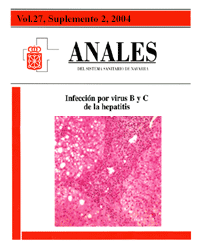Natural history of hepatitis C virus infection
Keywords:
Virus de la hepatitis C. Historia natural. Fibrosis. Cirrosis. Hepatocarcinoma.Abstract
The generally indolent, slow and protracted course of hepatitis C virus infection has limited the realisation of studies that evaluate its natural history. The aim of such studies has been the probability of death through hepatic disease, hepatic cirrhosis (compensated or decompensated), and/or hepatocarcinoma, or the development of a significant hepatic fibrosis (essential anatamopathological substrate for the development of the complications of hepatic cirrhosis). In spite of their possible limitations, the results of these studies show that chronic hepatitis C virus infection generally follows a benign evolutionary course, above all if this occurs in young patients (<50 years of age), without other aggravating factors of a possible hepatopathy (alcohol, coinfection by other viruses, immunosuppression) and if this is evaluated in the first 10-20 years of infection. At present, it is not possible to identify with precision those patients with HCV infection with a greater risk of developing a clinically relevant hepatic disease. However, it is likely that those subjects with high transaminases (> 2 times the normal value) and significant necroinflammatory activity (periportal necrosis) and fibrosis in the hepatic biopsy will show a more aggressive evolutionary course than those with normal transaminases and an almost normal hepatic biopsy.Downloads
Downloads
Published
How to Cite
Issue
Section
License
La revista Anales del Sistema Sanitario de Navarra es publicada por el Departamento de Salud del Gobierno de Navarra (España), quien conserva los derechos patrimoniales (copyright ) sobre el artículo publicado y favorece y permite la difusión del mismo bajo licencia Creative Commons Reconocimiento-CompartirIgual 4.0 Internacional (CC BY-SA 4.0). Esta licencia permite copiar, usar, difundir, transmitir y exponer públicamente el artículo, siempre que siempre que se cite la autoría y la publicación inicial en Anales del Sistema Sanitario de Navarra, y se distinga la existencia de esta licencia de uso.








